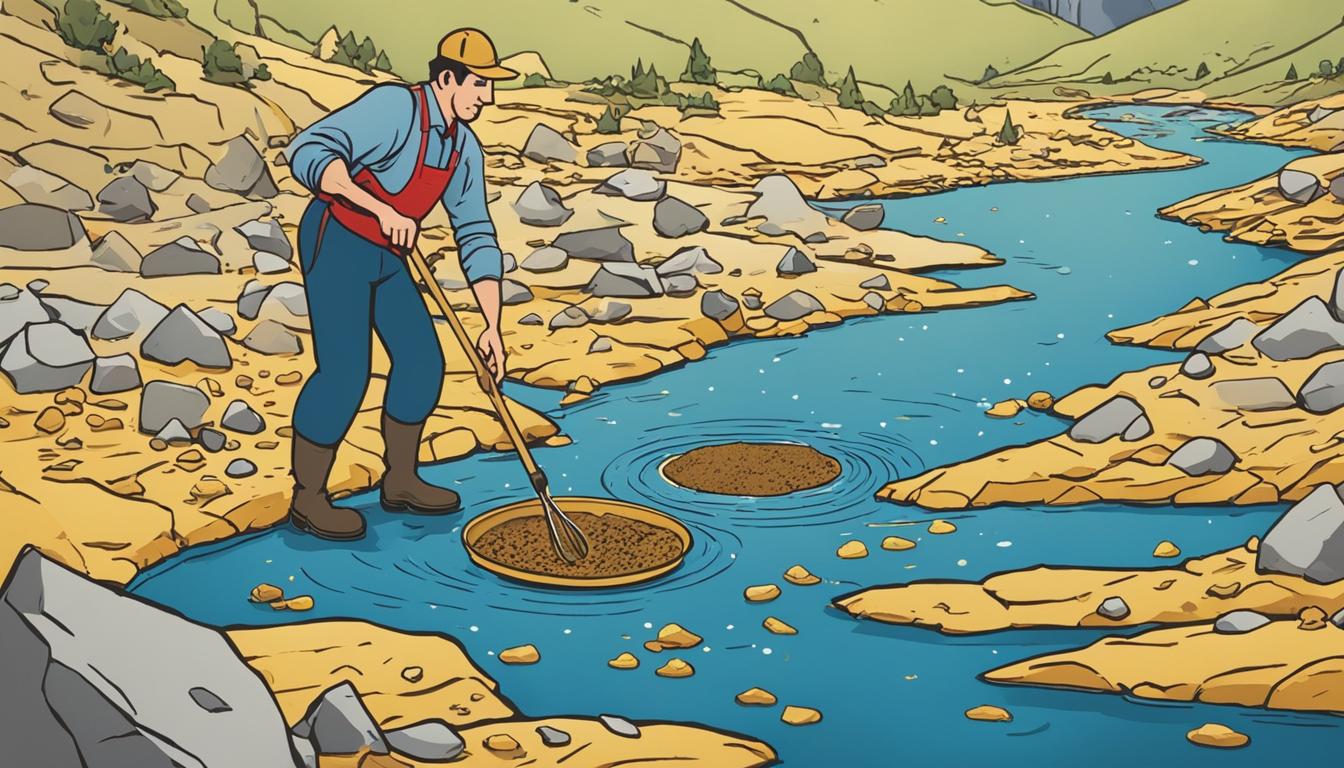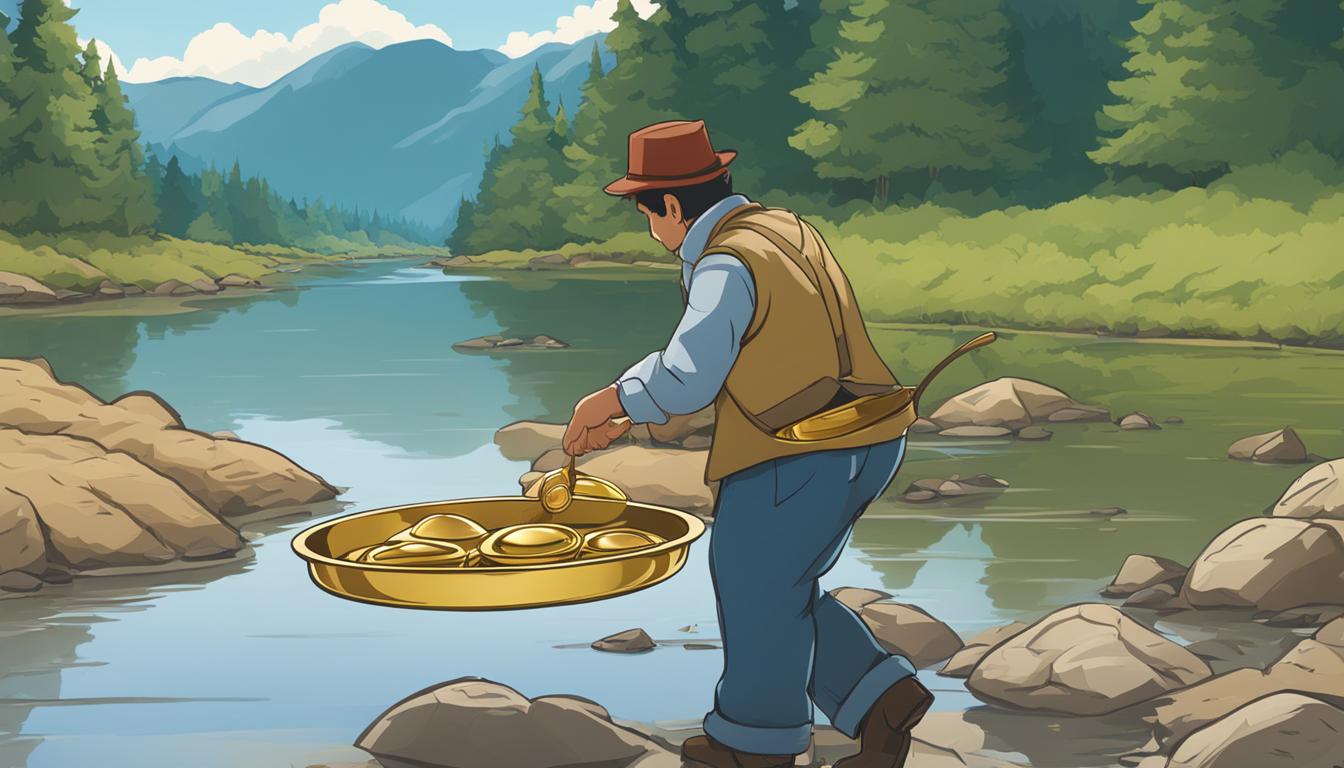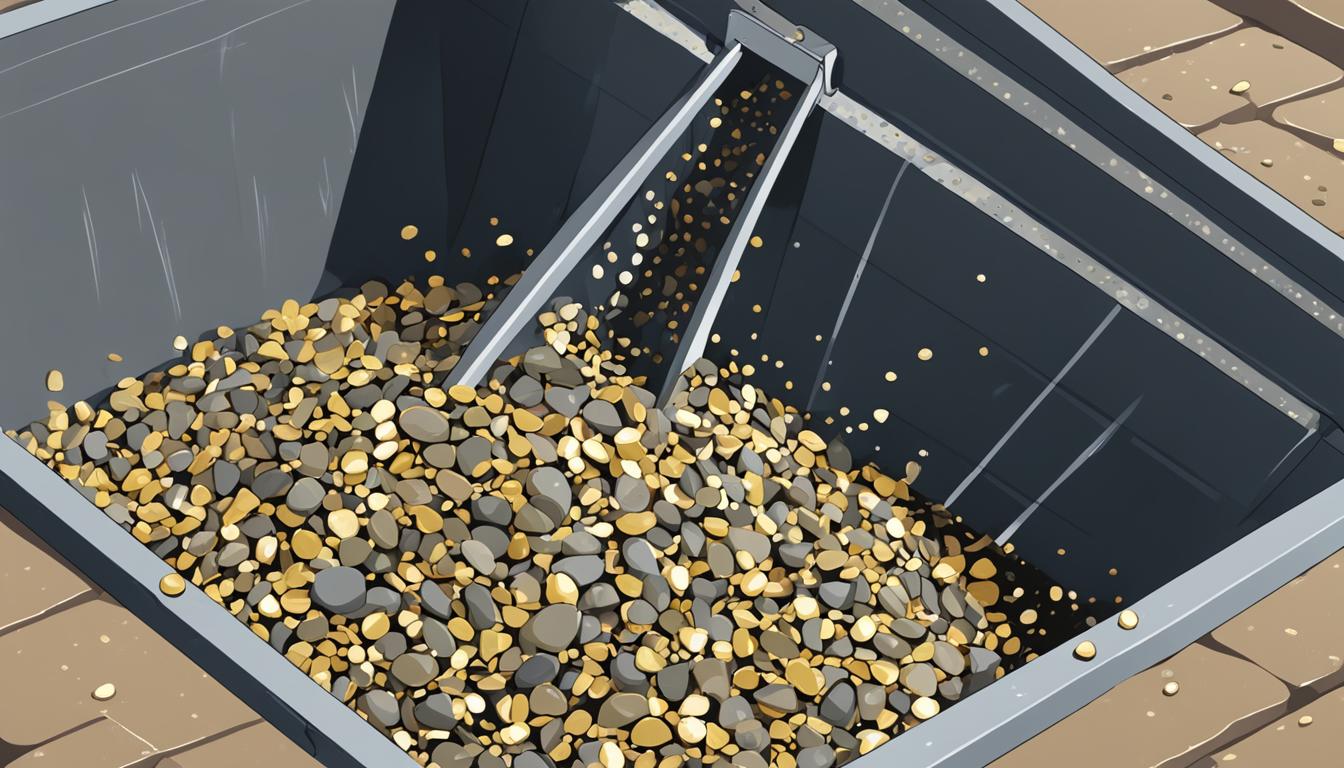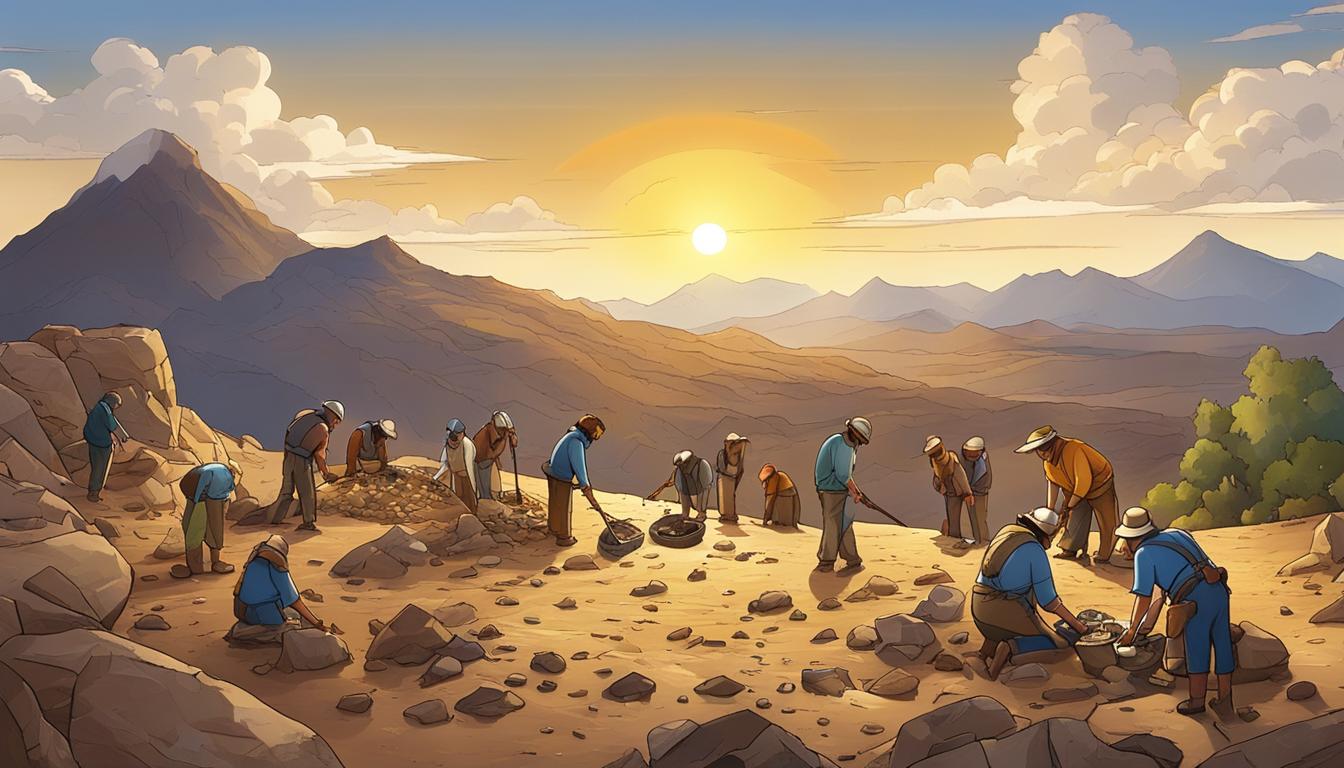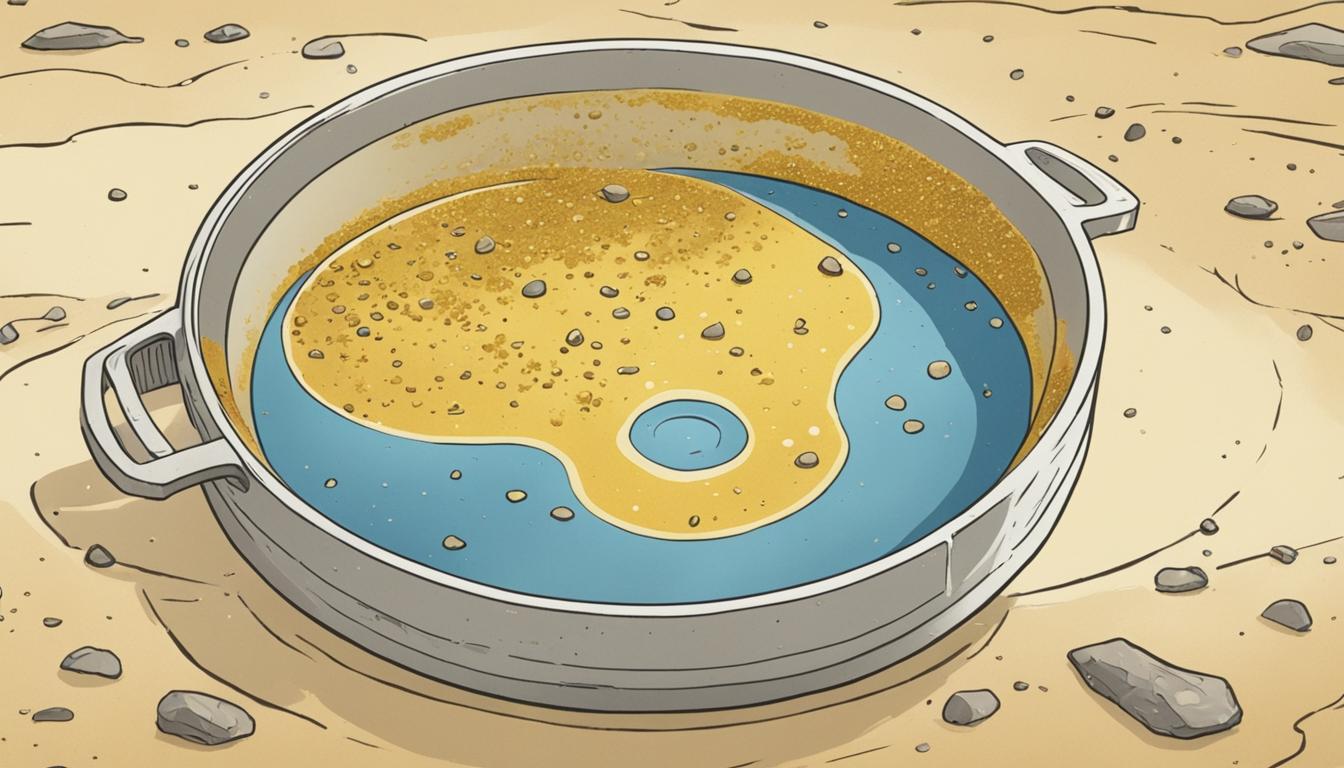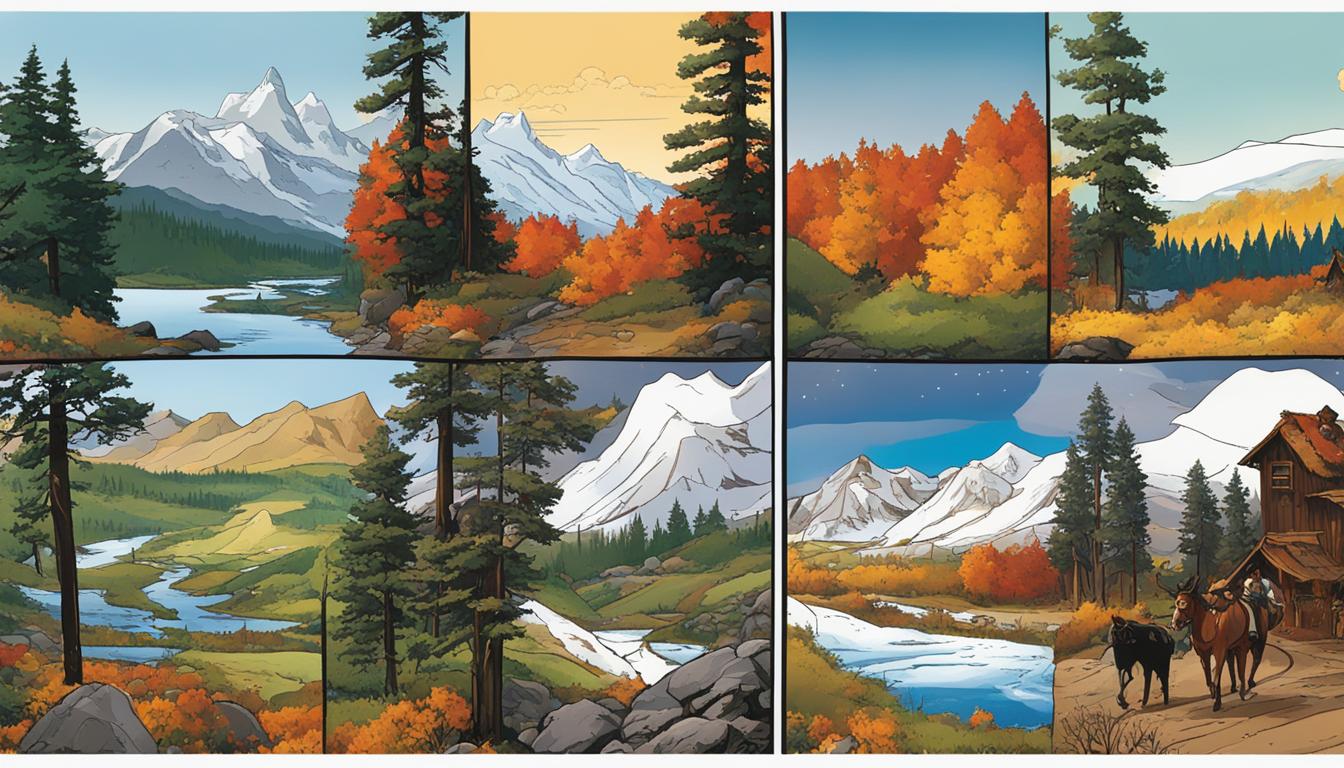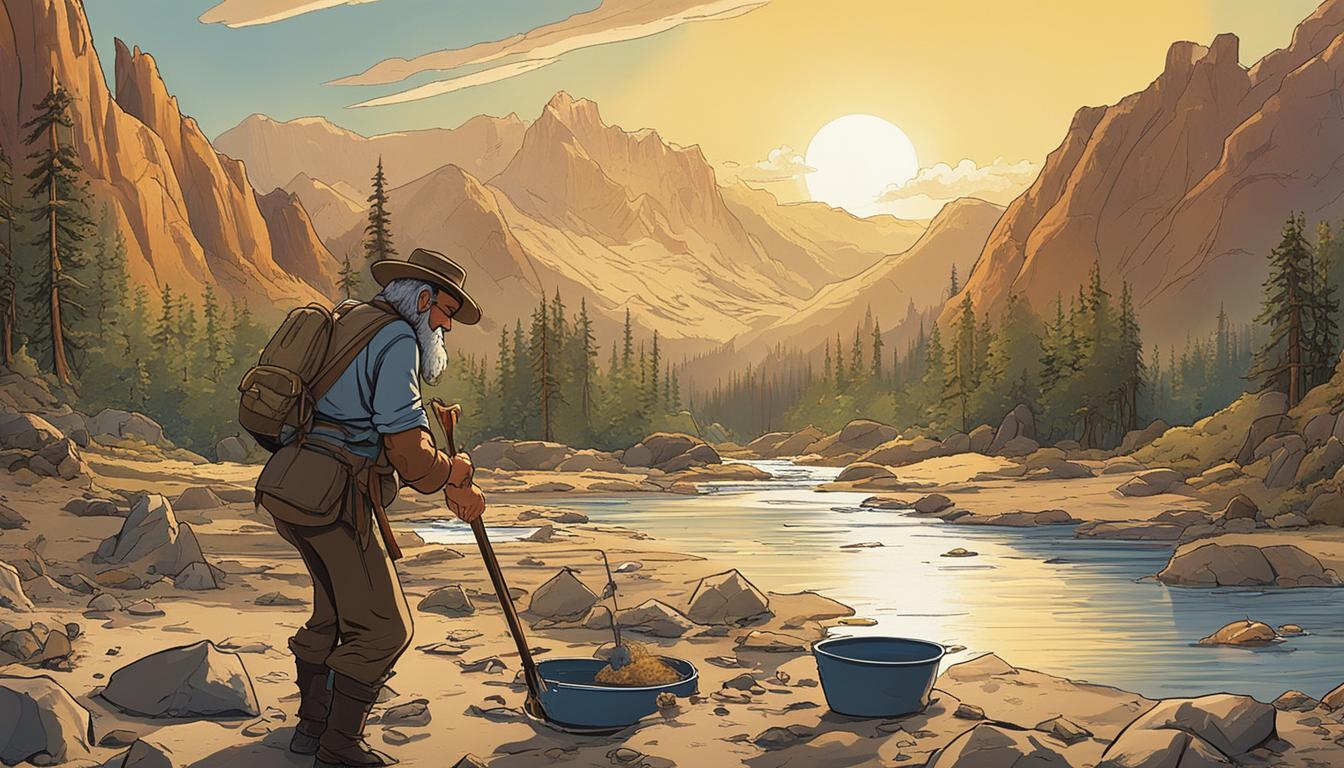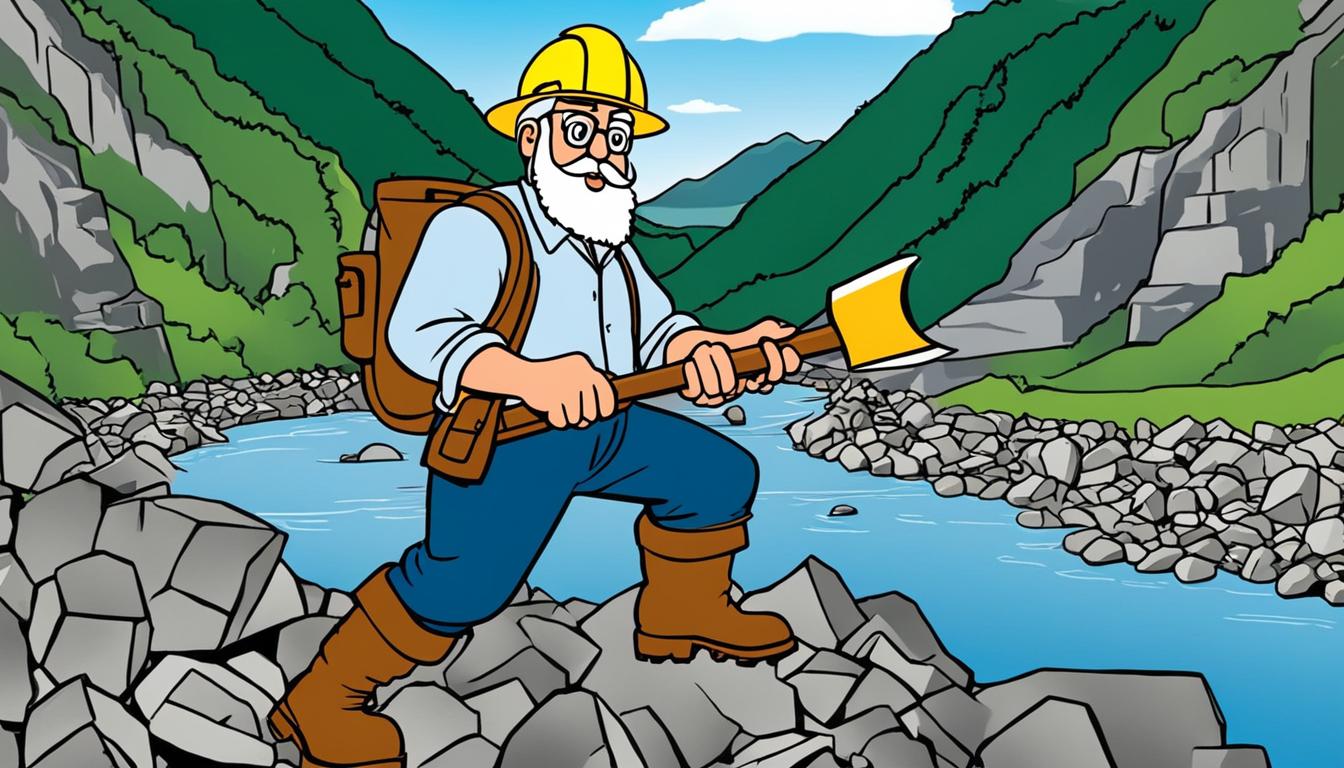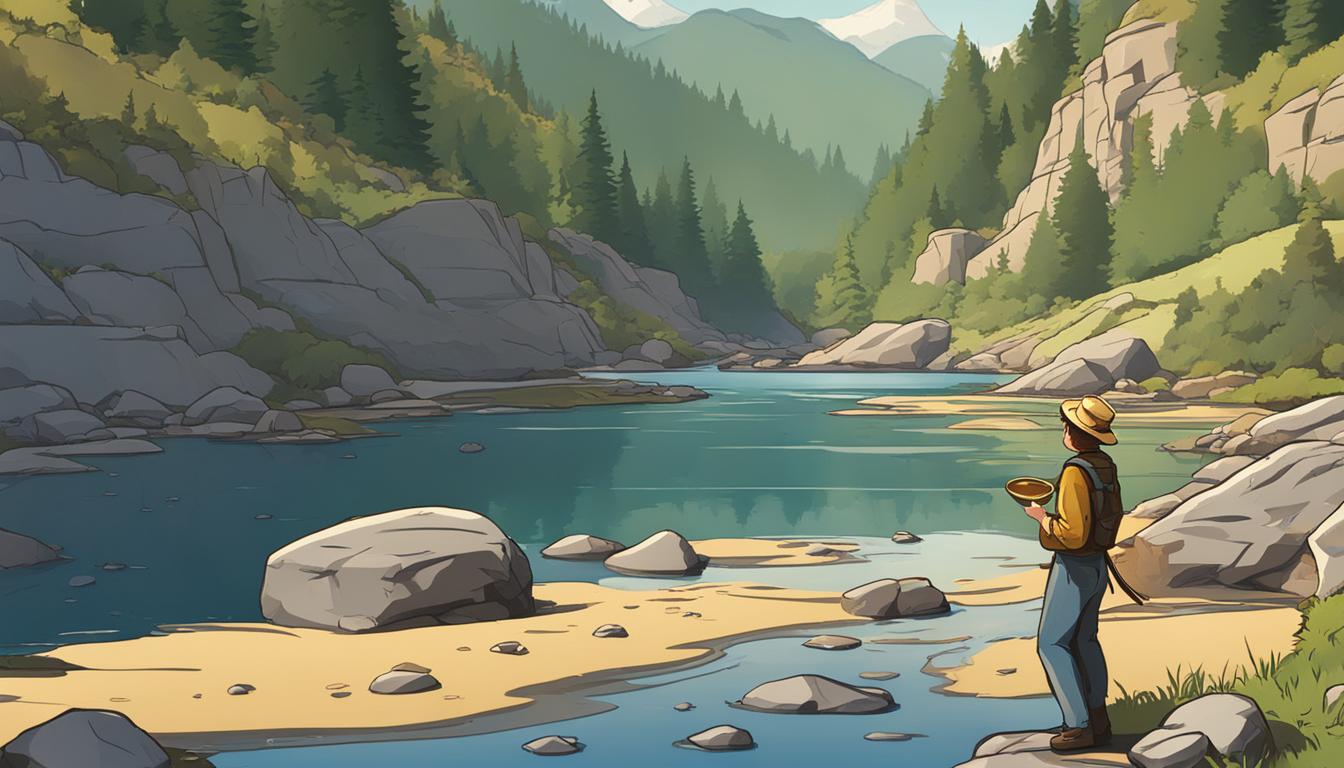
Gold panning is a popular activity in the United States, with millions of Americans trying their luck each year. The California Gold Rush in 1848 kickstarted the gold prospecting frenzy, and prospectors continue to search for gold in public areas across the American West. Selecting the right gold panning location is crucial for a successful experience. In this article, we will explore five national hot spots where you can begin your search for gold.
Key Takeaways:
- Choosing the perfect gold panning spot is essential for a successful gold prospecting adventure.
- The California Gold Rush in 1848 sparked the gold fever in the United States.
- We will explore five national hot spots where you can start your gold panning journey.
- These locations offer diverse landscapes and thrilling opportunities for both amateur and experienced gold prospectors.
- Stay tuned to learn about gold panning in Nevada, California, Alaska, Colorado, and Arizona!
Gold Panning in Nevada’s Rye Patch State Recreation Area
When it comes to gold panning, Nevada’s Rye Patch State Recreation Area in Lovelock is a must-visit destination for enthusiasts. Nevada is renowned for being one of the top producers of gold in the United States, and this state park offers ample opportunities for gold prospectors to try their luck.
While many of the highly productive areas in Nevada have been claimed for private use, there are still areas within Rye Patch State Recreation Area where amateur prospectors can pan for gold. The park’s scenic surroundings and rich history make it an excellent choice for both experienced and novice gold hunters.
One of the advantages of gold panning in Nevada is its dry and rocky terrain, which presents unique opportunities for finding gold. Two effective techniques that can yield success in this area are metal detecting and dry-washing.
Metal detecting allows prospectors to search for gold nuggets or hidden deposits that may be buried beneath the surface. The use of a metal detector can help identify potential hotspots and increase the chances of striking gold.
Dry-washing is another effective technique in Nevada’s arid environment. This method involves using a dry washer, which is a specialized piece of equipment that uses air and vibration to separate gold from lighter materials like sand and gravel. Dry-washing can be particularly useful in areas where water is scarce or where access to water is restricted.
Whether you choose to use a metal detector or employ dry-washing techniques, the key to successful gold panning in Rye Patch State Recreation Area lies in patience, persistence, and a bit of luck.
“Gold panning in Nevada’s Rye Patch State Recreation Area offers a unique experience for prospectors. The dry and rocky terrain, combined with the thrill of using a metal detector or dry-washing techniques, makes it an exciting adventure for all.” – Prospecting Enthusiast
Gold Panning Along the American River in California
The American River in California holds a significant place in history as the birthplace of the famous California Gold Rush. Even today, prospectors can still find gold nuggets in this historic river, making it a prime location for gold panning enthusiasts.
One of the best spots to indulge in this thrilling activity is the Auburn State Recreation Area. Located alongside the American River, this recreation area provides ample opportunities for panning gold. However, it’s important to note that gold-hunting equipment, other than gold pans, is prohibited in this area, ensuring a fair and egalitarian experience for all prospectors.
What makes gold panning along the American River particularly exciting is the phenomenon of melting snow. As snow from the nearby mountains melts, it washes down gold flakes into the river, increasing the chances of striking gold. This natural process creates a unique and enticing experience for gold prospectors, as they comb through the river’s sediment in search of those elusive shiny specks.
To give you an idea of the mesmerizing beauty of gold flakes and the excitement of gold panning along the American River, take a look at the image below:

So, if you’re a gold panning enthusiast or simply looking to try your hand at this exhilarating activity, head to the American River in California. Explore the Auburn State Recreation Area and immerse yourself in the rich history and potential treasures that this iconic river holds.
Gold Panning in the Alaskan Yukon River
Alaska boasts a rich gold mining history, with the famous Klondike Gold Rush attracting hundreds of thousands of prospectors in the late 19th century. Today, the allure of striking it rich still draws adventurers to the Last Frontier, particularly to the South Fork Koyukuk River, a prime location for amateur gold hunting.
The South Fork Koyukuk River, which branches off from the Yukon River, offers abundant opportunities for those seeking their fortune. While some areas have been commercially mined, many mining operations have shifted due to transportation challenges, leaving ample space for recreational prospecting. This creates an exciting atmosphere where amateur gold hunters can try their luck and potentially find significant treasures.
Watching the reality series “Gold Rush” can provide inspiration and valuable insights into the world of gold hunting in Alaska.
Notable Locations for Gold Panning in the Alaskan Yukon River
1. Circle City: Located on the banks of the Yukon River, Circle City served as a staging point for many prospectors during the Klondike Gold Rush. Today, it continues to be a popular destination for gold panning enthusiasts, with several local businesses offering equipment rentals and guided tours.
2. Dawson City: Situated at the Klondike River’s confluence with the Yukon River, Dawson City played a pivotal role in the historic gold rush. Its rich mining history and scenic beauty make it an attractive spot for recreational prospecting.
3. Nome: Famous for its beach gold deposits, Nome attracts adventurers from far and wide. The Bering Sea’s erosive forces have concentrated gold along the shoreline, making it an ideal location for amateur gold hunters looking for a unique experience.
Amateur Gold Hunting Tips in the Alaskan Yukon River
“To increase your chances of success, it’s important to acquaint yourself with the local regulations and guidelines regarding gold panning. Additionally, investing in quality equipment and understanding how to read the river’s currents can greatly enhance your ability to find gold. Remember, patience and persistence are key virtues in the world of gold hunting!”
Beginners to gold panning in Alaska may find it beneficial to join local prospecting clubs or network with experienced miners for valuable tips and advice. Remember, the journey of gold hunting in the Alaskan Yukon River is an adventure of a lifetime that combines history, natural beauty, and the thrill of finding gold. So, gear up, plan your trip, and let the search for Yukon gold commence!
Gold Panning in Colorado’s Cache Creek Area
Colorado boasts a rich mining heritage, making it an ideal destination for gold panning enthusiasts. One of the top spots to explore in this beautiful state is the Cache Creek area located in Twin Lakes. Cache Creek was once home to a thriving gold mine that operated for over 50 years before its closure due to environmental concerns.
Today, Cache Creek is open to recreational mining, offering individuals the opportunity to try their luck at finding gold flakes and nuggets. However, it’s important to note that strict rules are in place to ensure environmental preservation. Only non-motorized prospecting tools are allowed, and an entrance fee is required to access the area.
Recreational mining in the Cache Creek area allows visitors to experience the thrill of gold prospecting while also appreciating the natural beauty of Colorado. The picturesque Twin Lakes and surrounding mountains provide a stunning backdrop as you immerse yourself in the excitement of searching for that elusive gold speck.
“Recreational mining in Cache Creek offers a unique blend of adventure and appreciation for our natural resources,” says John Anderson, a seasoned Colorado prospector. “It’s a chance to connect with Colorado’s mining history while preserving the environment for future generations.”
Environmental Preservation in Cache Creek
Environmental preservation is at the forefront in the Cache Creek area. Mining activities must align with strict regulations to safeguard the delicate ecosystem and maintain the area’s natural beauty. By using non-motorized tools, prospectors minimize the impact on the environment and reduce disturbances to wildlife habitats.
Cache Creek’s focus on environmental preservation ensures the sustainability of recreational mining for years to come. It also offers an opportunity for visitors to learn about responsible mining practices and the importance of preserving our natural resources.
Tourism and Local Economy
Recreational mining in Cache Creek not only offers an exciting experience but also contributes to the local economy. The influx of visitors who come to try their luck at gold panning supports local businesses such as accommodation providers, restaurants, and tour operators.
Jessica Thompson, owner of a local bed and breakfast, remarks, “Cache Creek is a hidden gem attracting gold prospectors from all over the country. The recreational mining industry has brought new opportunities for small businesses like mine, contributing to the growth and sustainability of our local community.”
The following table provides an overview of the economic impact of recreational mining in Cache Creek:
| Community | Businesses Affected | Economic Contribution |
|---|---|---|
| Twin Lakes | Hotels, restaurants, tour operators | $500,000 annually |
| Leadville | Retail stores, equipment rental | $250,000 annually |
| Countywide | Transportation services, souvenir shops | $1 million annually |
As recreational mining continues to be a popular activity in Cache Creek, the local economy is thriving, highlighting the positive impact of gold prospecting on the region.
So, if you’re in search of adventure and a chance to strike gold, head to Colorado’s Cache Creek area. Immerse yourself in the natural splendor, follow the environmental guidelines, and let the thrill of gold panning create lasting memories.
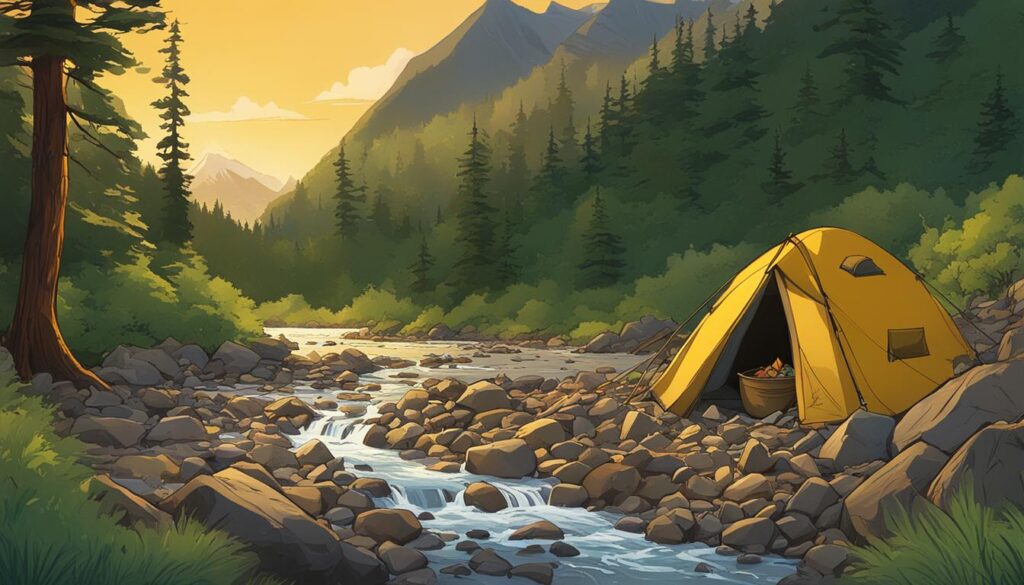
Gold Panning in Arizona’s Lynx Creek
Although Arizona is known for mining copper, silver, and turquoise, it is also ranked fifth nationally in gold production. One of the prime locations for gold panning in Arizona is Lynx Creek, nestled in the picturesque Bradshaw Mountains within the Prescott National Forest. This area offers over 100,000 acres of land and 950 miles of trails for gold prospectors to explore.
The Lynx Creek area is a dry region, ideal for gold panning. Prospectors can enjoy the tranquility of this scenic river oasis while searching for gold flakes. The majestic beauty of the Bradshaw Mountains creates a captivating backdrop for the gold panning experience.
Regulations exist for recreational mining in the area, but the Lynx Creek and Lynx Lake regions have remained open for gold prospectors. This allows enthusiasts to indulge in their passion while following the guidelines set forth by the forest authorities.
Explore the natural wonders of Lynx Creek and test your luck at finding gold in this stunning Arizona location.
“Lynx Creek offers a unique gold panning experience in the heart of Arizona. With its scenic river oasis and vast expanse of land, it is an idyllic location for both amateur and experienced prospectors. Discover the hidden treasures of the Bradshaw Mountains and create memorable moments while indulging in the age-old activity of gold panning.”
Tips for Gold Prospecting in Rivers, Creeks, and Streams
When it comes to gold prospecting in rivers, creeks, and streams, there are several tips and techniques that can help you maximize your chances of finding gold. In this section, we’ll explore some valuable insights to enhance your gold prospecting experience.
- Look for both fast and slow-moving water: Gold can get trapped in bends and areas where water flow is altered by obstacles. So, be sure to explore both fast and slow-moving areas to increase your chances of finding gold.
- Obstacles for gold trapping: Keep an eye out for obstacles such as rocks, boulders, and log jams. These can create pockets where gold can accumulate, making them ideal spots for prospecting.
- Pay attention to indicators of gold presence: Certain minerals can act as indicators that gold might be present. Keep an eye out for black sands, pyrite (also known as fool’s gold), and small quartz. These can be signs that gold is nearby.
- Confluence zones: Where two rivers or streams meet can be excellent locations to find gold. The confluence can create ideal conditions for gold deposition, so be sure to explore these areas thoroughly.
Understanding the geological characteristics of the area: Having a basic understanding of the geological composition of the region you are prospecting in can greatly assist in identifying potential gold-rich spots. Research the area beforehand and look for geological features that are favorable for gold accumulation.
By implementing these tips, you can improve your gold prospecting results in rivers, creeks, and streams. Stay observant, be patient, and enjoy the thrill of the search!
[Image description: A serene image of a river flowing through a beautiful landscape, representing the experience of gold prospecting in rivers, creeks, and streams.]
Tips for Gold Prospecting in Deserts
Prospecting for gold in deserts requires a different approach compared to rivers and streams. Understanding the unique characteristics of desert environments can significantly improve your chances of finding gold. Here are some valuable tips to consider:
Look for Areas with Slowed Water Current
In desert regions, water flow is often scarce, but it can still play a crucial role in gold prospecting. Gold tends to settle and sink to bedrock in desert areas where the water current has slowed down. These areas include depressions and bedrock fissures, which are perfect spots for finding gold. Take your time to explore such locations and thoroughly inspect the surrounding terrain.
Explore Dry Washes
Dry washes, also known as dry riverbeds, are another promising location for finding gold in deserts. During heavy rainstorms or flash floods, water rushes through these channels, carrying gold particles with it. When the water evaporates, the gold settles in the dry washes, waiting to be discovered. Use your gold pan or dry-washing techniques to sift through the sediment and uncover hidden treasures.
Consider Transplanted Gold
One fascinating aspect of gold prospecting in deserts is the presence of transplanted gold. Gold can be carried to arid environments through runoff, flash floods, and rainstorms from other regions. This means that even in seemingly barren deserts, gold can still be found. Keep in mind that transplanted gold may offer unique opportunities in deserts that wouldn’t otherwise support gold deposits.
“When prospecting in deserts, it’s important to have patience and to carefully observe the characteristics of the landscape. Slowed water current areas, such as depressions and bedrock fissures, as well as dry washes, can hide the precious yellow metal.” – Experienced Gold Prospector
To enhance your understanding of gold prospecting in deserts, here’s an image illustrating the beauty and challenges of the desert landscape:
| Desert Prospecting Tips | Benefits |
|---|---|
| Search for areas with slowed water current | – Higher chance of finding gold deposits |
| Explore dry washes | – Gold settles in dry riverbeds after flash floods |
| Consider the presence of transplanted gold | – Gold can be carried to deserts from other regions |
In summary, gold prospecting in deserts requires a keen eye, patience, and an understanding of the landscape. By searching for areas with slowed water current, exploring dry washes, and considering transplanted gold, you can increase your chances of finding valuable gold deposits. So, grab your gold pan, head out to the deserts, and embark on an unforgettable gold hunting adventure!
Conclusion
Selecting the ideal gold panning location is crucial for a successful gold prospecting experience. By understanding the history and geological characteristics of different areas, prospectors can find the best spots to search for gold. Throughout this article, we have explored national hot spots in Nevada, California, Alaska, Colorado, and Arizona, each offering diverse landscapes and unique opportunities.
Whether you prefer metal detecting in Nevada, panning along the historic American River, or embarking on an exhilarating gold hunt in Alaska or Colorado, these ideal gold panning spots provide exciting adventures for both amateur and experienced prospectors. Each location has its own charm, from the dry and rocky terrains of Nevada to the scenic river oases of California and the rugged landscapes of Alaska and Colorado.
In conclusion, the ideal gold panning spots mentioned in this article offer a variety of experiences for gold prospectors. By immersing yourself in the rich history and natural beauty of these locations, you can increase your chances of finding gold and create lasting memories along the way. So grab your gold pan, explore these diverse regions, and embark on your own gold prospecting journey!
Source Links
- https://www.smithsonianmag.com/travel/five-places-where-you-can-still-find-gold-in-the-united-states-180982063/
- https://www.goldrushnuggetbucket.com/pages/where-to-prospect-for-gold
- https://www.farandwide.com/s/best-places-pan-gold-gemstones-095e3175eb2946b9

Meet Ryan Conlon, the passionate owner and driving force behind Pan for Treasure.
With an unwavering love for the art of gold panning, Ryan has transformed his enthusiasm into a thriving community hub for fellow treasure seekers. [email protected]
A seasoned gold panning enthusiast, Ryan’s journey began with a simple pan and a dream, evolving into a deep appreciation for the history, geology, and thrill of uncovering precious metals.


